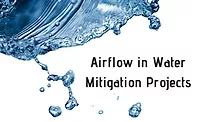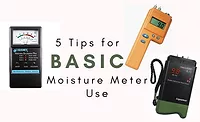Top Tips for Moisture Meter Use in Water Mitigation
The ANSI/IICRC S500 and Meters – What is Standard of Care?
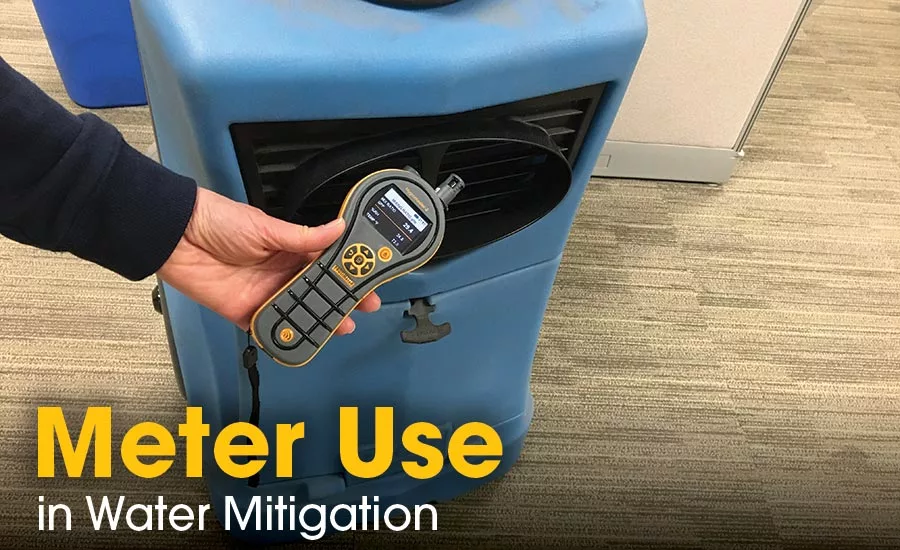
The water damage restoration industry recognized standard of care, the ANSI/IICRC S500, contains a significant amount of information related to the use of meters during a drying project. The most important content is primarily in two sections; Section 10 Inspections, Preliminary Determination, and Pre-Restoration Evaluations, and Section 13, Structural Restoration.
Looking through the standard, the restoration professional can answer several important questions related to meter use.
What is a meter?
It seems a pretty simple question, but an important one to discuss. Meters are defined as devices that provide a quantified representation of the amount of moisture present in a material, either as a moisture content or a moisture level. This is a critical distinction from devices that simply indicate the presence of moisture with no numerical value, a device commonly referred to as a moisture sensor.
What meters are required?
The standard of care does not dictate which specific devices are required. Instead, it addresses what information is required, then suggests a list of devices that ‘may be used’ to acquire that information. In other words, it is required that restorers evaluate and document several things. This includes the extent of moisture migration, relevant moisture readings on a daily basis, drying goals (based on dry standards) and psychrometric values and calculations. Some sections even specifically cite assemblies such as hardwood floors, gypsum wallboard and other built up assemblies where ‘inspection and documentation of moisture’ is required.
It is suggested, however, that moisture readings will ‘normally include’ temperature and relative humidity outside and in affected and unaffected areas, and at dehumidifiers, and the moisture content of affected materials.
Based on the type of data that is required, and other discussions in the document related to devices that can assist in understanding water migration, the standard suggests that meters ‘can’ include several devices, such as moisture sensors, thermos-hygrometers, invasive and non-invasive moisture meters, infrared thermometers and thermal imaging cameras (which should be verified with a moisture meter).
When are meters used?
There are three primary times that meters are critical to the process. Initially, it is required that the degree of migration be evaluated and documented. This includes the identification of each material affected, the degree of wetting, and the exact edge of migration. It also includes evaluating the air in the structure and related temperature and humidity. Second, the standard requires that this information be assessed again each day, but the frequency “may be adjusted by the agreed scope of work, potential for secondary damage, job site accessibility, or by agreement between the materially interested parties.” Lastly, drying goals must be verified at the completion of the project.
How are meters used?
The value of monitoring data is equal to the integrity of the monitoring process. In order to ensure the restorer can make meaningful decisions about the performance of a drying system, data needs to be captured using methods that are consistent with each visit to the project.
The standard addresses the need for consistency by calling out the differences in calibration that occur from one instrument to another. Based on those differences, restorers are required to use the same meter throughout a project or establish an in-house method to verify that meters used are within a reasonable tolerance of each other.
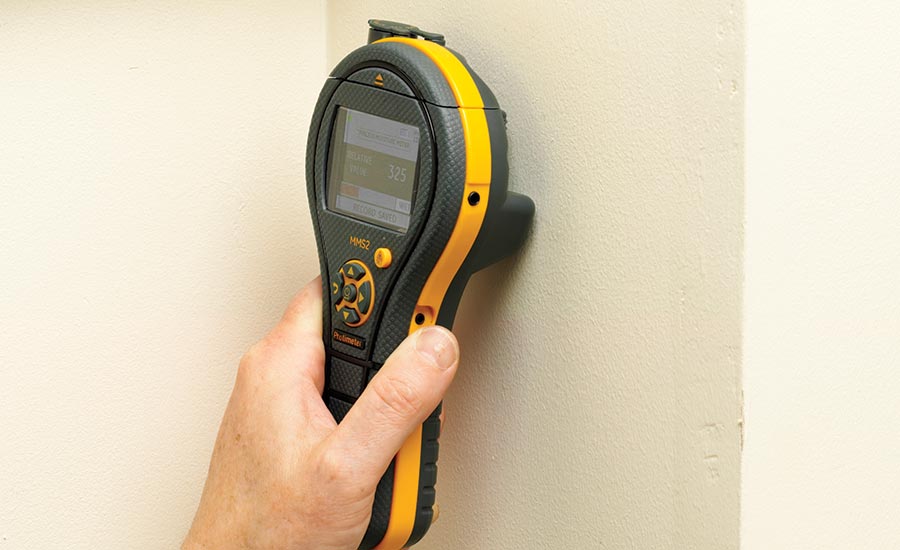
Where are meters used?
The location for meter use is based on the structure and moisture migration. It is necessary to track migration as discussed earlier until the exact edge of migration has been identified. As this is done, it is further required to identify the materials that are affected. The standard makes clear distinction that this necessitates the identification of each affected material within assemblies, and that the data related to moisture must be documented for each material identified.
The standard further discusses the exact location of meter use, recommending that meters be used in the same location each day of the monitoring process, and at the same approximate time of day.
Meter Types – what should be in your kit?
Based on the discussion above, there are three instruments that should be in every inspection kit, at a minimum. A device to measure and calculate psychrometric values, and at least two devices for evaluating material moisture content or moisture level. There are two primary types of moisture measurement used in the restoration industry: pin and non-invasive. Both methods have pros and cons and a combination of both methods is generally preferred by the industry.
Non- invasive moisture measurement
This method is excellent for completing a rapid initial investigation of the affected area and quickly allows the operation the ability to map out excessive moisture in the property. This method can also be used to look below floor and wall coverings to search for moisture that may not available to measure with a pin type meter. This type of technology has its drawbacks too as it generally not as accurate as pin type meters and can also give false positives if there is conductive material under the surface such as metal. Some meters can also give full scale readings even if the moisture is only on the surface due to condensation.
Pin type meters
Pin type resistance measurement is a generally more reliable and repeatable method of moisture measurement in a wide range of building materials. It also allows operators to add and use accessories such as deep wall probes and hammer electrodes to go deeper into materials. The probes on these accessories are insulated and only measure on the tip, allowing diagnosis of moisture at different depths.
The two pins on the end of the meter are too often pushed deep to the material. The best practice is just to break the surface of the material to get the measurement and avoid or reduce the repair of meter pin holes in the walls and ceilings.
It is recommended that readings from the pin meters be used as the primary recording method of the moisture condition during the drying process.
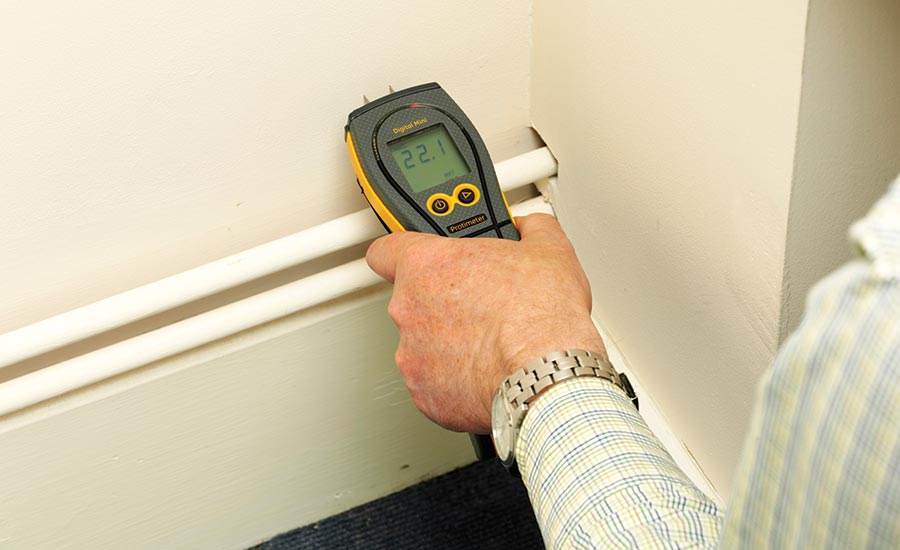
Thermo-Hygrometers
These handheld hygrometers are critical to measure the output of the dehumidifiers. Measuring the humidity in the air both on the input and output of the dehumidifier in grains per pound allows restorers to calculate the drying rate as well as adjust the number of dehumidifiers on the job. All hygrometers sold in the industry are polymer-based humidity sensors. However, there are many different performance characteristics of these meters. When visiting a jobsite and recording readings most of the time is taken up making humidity readings. For this reason, it is important that a fast responding hygrometer with a 2% accuracy is used. Investing in a higher performance product has a very fast payback. When using a hygrometer, these best practices should be used.
- Take measurements in temperature order going from low temperature to high temperature or vice versa depending on the temperature the hygrometer has been stored at.
- To get the most accuracy, make sure the hygrometer has fully stabilized as you are taking all the required measurements.
- Check the accuracy of your hygrometer regularly and replace the sensor annually if your hygrometer has a replaceable sensor tip.
- Always keep in a dust and dirt-free environment to prolong accuracy of the sensor.
Getting a hygrometer that calculates psychometric readings such as grans per pound will save mistakes using calculators and save time. The more accurate your measurements, the better your team will be able to plan out and track the drying process - hopefully leading to more quickly-approved and paid bills, and happy customers.
Looking for a reprint of this article?
From high-res PDFs to custom plaques, order your copy today!




